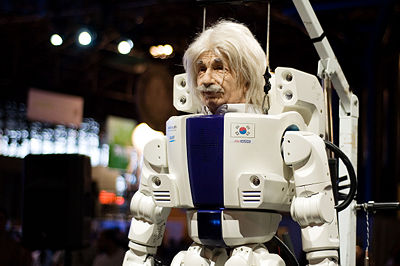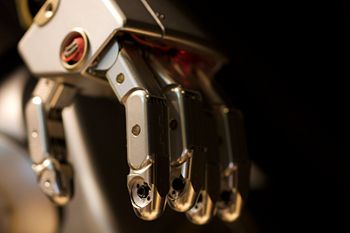HUBO
|
HUBO is a humanoid robot originally developed at the Korea Advanced Institute of Science and Technology and currently undergoing joint research by Korean and American universities. The first HUBO, KHR-3, was the culmination of four years of research based on three earlier prototypes, and it was officially unveiled to the public on January 6, 2005.[1] The name HUBO is short for "HUmanoid roBOt".[2]
Development history
The first HUBO (KHR-3) was developed by mechanical engineering professor Oh Junho and his Ph.D. student teams over the course of about 20 years. During much of this time, the technologies relevant to HUBO were acquired at a steady pace with contributions from within KAIST. This informal approach resulted in a very low development cost of around $500,000 by the time of KHR3's completion. (In comparison, Honda is believed to have spent $300 million on ASIMO between 1986 and 2000.)[3][4]
Prototypes
The first prototype was the KHR-0 (KAIST Humanoid Robot), consisting of two legs without an upper body. It was built in 2001 with the purpose of investigating the specifications of the actuators (devices that receive electric signals and perform mechanical actions) and the optimal design parameters of the humanoid robot.[5][6]
The second prototype, the KHR-1, was completed by January 2002. The KHR-1 was approximately humanoid in form without a head and two hands, which are nonessential for simulating walking. Its purpose was to demonstrate autonomous walking that involves real-time motion control through sensory feedback. (This involves constant adjustments that are absent in walking as a playback motion adopted from an offline learning process and walking with partial online adjustments.) It could make right turns and walked at 0.8km/hr.[5][7][8][6]
The project was continued with the development of KHR-2 from 2003 to 2004. The KHR-2 was built as a complete humanoid and featured better sensoring with the addition of CCD cameras, inertia sensors, and tilt sensors.[9] It was used as a platform for simulation of vision-guided dynamic walking, in which the robot keeps focus on a moving red light for direction.
KHR-3 HUBO
Work on the KHR-3 HUBO was begun in September 2004. The internal components were covered with metallic grey plastic, and modifications were made to the joints and and the skeleton for greater stiffness and minimal mechanical uncertainty. The KHR-3's physical specifications, such as height, weight, and the number of DOFs (degrees of freedom), were similar to Honda's ASIMO, which served as the benchmark for the project. In terms of AI and movements, HUBO fell short of the "next-gen ASIMO," which was unveiled around the same time as HUBO in December 2004; for example, HUBO could only walk half as fast as the ASIMO (1.25 km/h vs 2.5 km/h), which could also run at 3 km/h. A temporary shortcoming for HUBO was that it was unable to walk up and down stairs for several months since its initial publicity, needing further development. The unnerved KAIST researchers noted, however, that HUBO could play rock-paper-scissors, which was impossible for ASIMO since its fingers could not move independently of each other.[10][11][12]
International collaboration
The project became increasingly international with participation from the United States. The first collaboration involved Hanson Robotics in the development of Albert HUBO, which was completed in November 2005. The Albert HUBO's body was a derived version of the KHR-3 HUBO's with a human-like head of Albert Einstein from the Hanson lab. The head had a skin of Frubber that is often used in movie productions, and underneath it had 35 joints to make realistic facial expressions. Like its predecessors, it possessed 2 CCD cameras for vision recognition.[2]
The subsequent collaboration on the Jaemi HUBO (also known as KHR-4 and HUBO 2; "Jaemi" (재미) can mean "in the United States" in Chinese characters or "fun" in colloquial Korean) was a more extensive and strategic effort to combine Korea's expertise in humanoid design with the US's strength in cognition, perception, navigation, and networking. It involved participation of KAIST, Korea University, and the Seoul National University in South Korea, and the Bryn Mawr College, Colby College, Drexel University, the University of Pennsylvania, and Virginia Tech in the United States under a $5 million dollar, 5-year program funded by the National Science Foundation.[13]
The Jaemi HUBO's initial development concerning the mechanical aspect was done at KAIST from 2008 to 2009. The Jaemi HUBO was given a slimmer design with an aluminum endoskeleton and a polycarbonate frame, resulting in a slightly taller height but a 20% lighter weight than its predecessors. Its movements were more realistic since the arms made quicker and more natural motions, and the legs could stretch to imitate human walking, which also consumes less energy than the traditional humanoid walking based on ZMP trajectory (see below). Its walking speed was improved to 1.4 km/h, and it also acquired the ability to run at 3.6 km/h (which is still much slower than the new ASIMO's 6 km/h by comparison).[14][15][16]
Design and engineering principles
Central to HUBO's successful development was its focus on simpler and feasible design and movements. For HUBO to be light and efficient, its height was set similar to a child's, and the body was later made with special materials (Jaemi HUBO). Its autonomous design without external connections was both a way to simulate walking and also a part of the efforts to reduce its exposure to external factors that would complicate its movement and increase chances of error.
All models were built with harmonic drives in order to avoid backlash in the gears and to achieve a light, compact design. The DOFs of the different axes in the joints of shoulders, waist, hips, and ankles were merged into intersections in order to attain a simple, closed-form solution (that is, comprised of well-known mathematical functions) of inverse kinematics (the computation of the robot's movements).
HUBO's walking from KHR-1 to KHR-3 followed the Zero Moment Point trajectories (points of contact on the ground where the total moment of inertia of the active forces equals to 0) predicted with a simple model of the robot.[5][8][6]
To resolve this problem, the biped was set to a virtual under-actuated robot with
a free joint at its support ankle, and a fixed point for a virtual system was determined.
Following this, a new periodic running pattern was formulated using the fixed point.
Resolved momentum control uses the linear and angular momentum of the robot.
Therefore, it has an advantage in that the movement of the biped is instinctively
observable.With resolved momentum control, the total angular momentum is forced
to zero in order to prevent rotation of the biped during the flying phase. However, this causes unnatural movement of the upper body of the biped. This problem is addressed through the use of a fixed point of an under-actuated system.
The running pattern is a periodic function employed to realize continuous running of a robot. This implies that the initial state and the end state of the running cycle are always equal. However, the rotation of the robot during the flying phase when running can lead to an undesirable type of landing. This in turn can create a difference between the initial state and the end state of the running cycle. That is, repetitive running is impossible due to the absence of a periodic running cycle. To solve this problem, it is necessary to consider the rotation of the biped about the y-axis when the running pattern is generated. To prevent this non-periodic running pattern, the angular momentum of the COM about the y-axis, LY COM, is held at zero, which prevents rotation of the biped. Alternatively, an ideal trajectory of the angular momentum of the COM that leads to a periodic running pattern can be created. However, if the LY COM trajectory is set to zero, it creates an unnatural motion of the upper body of the biped. The motion of the upper body offsets the angular momentum of the y-axis that is induced by the motion of the COM in the x-direction. If the biped runs faster, the angular momentum of the y-axis is larger. To counteract this, the upper body of the biped must move rapidly, leading to an unnatural motion. In addition, it is nearly impossible to find an ideal LY COM trajectory to create a periodic running pattern. Therefore, a new running pattern generation is proposed to solve this problem. The procedure is as follows. First, the trajectories of all the joints are calculated by the modified resolved momentum control; this alone does not guarantee a periodic cycle. Second, it is assumed that the biped is a virtual under-actuated robot in which the ankle joint of the support is free, such as in the case of a passive walker. If the sole of the simple model in Fig. 3 is eliminated, the virtual under-actuated robot can be imagined easily. In addition, the trajectories of the knee- and hip-joints calculated by the modified resolved momentum control are set to the trajectories of knee- and hipjoints of a virtual under-actuated biped. Because it is an under-actuated biped, the final angle and angular velocity of the stance ankle are varied according to the initial angle and angular velocity of the stance ankle. Third, a Poincare map of an under-actuated biped is set, and a fixed point, in which the initial value and the final value are the same, is found by a numerical iteration. Finally, the trajectory of the stance ankle of the virtual under-actuated biped making a periodic cycle is applied to an actual fully actuated biped. This process creates periodic running. [17]
Notes
- ↑ Birth of Korean Humanoid Robot Marks Brilliance Advance in Korea Robotics, Chosun Ilbo. 2004-12-22.
- ↑ 2.0 2.1 Specification of Albert HUBO, Hubo Lab. Date accessed: 2009-02-24.
- ↑ 한국형 휴먼로봇 '휴보' 탄생, Chosun Ilbo. 2004-12-22.
- ↑ Korean Robotics Steps Into the Future, Lee Sung Kyu and Todd Thacker, OhmyNews International. 2005-01-18.
- ↑ 5.0 5.1 5.2 Oh, et al, "Design and Walking Control of the Humanoid Robot, KHR-2(KAIST Humanoid Robot - 2)," 2004.
- ↑ 6.0 6.1 6.2 Oh, et al, "Mechanical Design of the Humanoid Robot Platform, HUBO," 2007.
- ↑ Introduction of KHR-1, Hubo Lab. Date accessed: 2009-02-20.
- ↑ 8.0 8.1 Oh, et al, "Development of a Humanoid Biped Walking Robot Platform KHR-1 - Initial Design and Its Performance Evaluation," 2002.
- ↑ Introduction of KHR-2, Hubo Lab. Date accessed: 2009-03-09.
- ↑ Specification of KHR-3 (HUBO), Hubo Lab. Date accessed: 2009-02-24.
- ↑ Honda Reveals Technologies Next-Generation ASIMO, Honda. 2004-12-15.
- ↑ Korea to unveil stair-walking robots, Korea.net. 2006-02-25.
- ↑ U.S. and Korean Researchers Unveil Newest Research Team Member: Jaemi the Humanoid, NSF. 2009-06-01.
- ↑ KAIST 휴보 '미국 로봇 교과서'로 쓰인다, Chosun Ilbo. 2009-06-08.
- ↑ Introduction of HUBO (KHR-4), Hubo Lab. Date accessed: 2009-11-09.
- ↑ 시속 3.6㎞로 뛰는 로봇 세계 세 번째로 개발, JOINS. 2009-12-05.
- ↑ Cho and Oh, 2009. pp.
- Incompatible editor status
- Editable Main Articles with Citable Versions
- CZ Live
- Computers Workgroup
- Engineering Workgroup
- Physics Workgroup
- Technology Subgroup
- Articles written in British English
- Advanced Articles written in British English
- All Content
- Computers Content
- Engineering Content
- Physics Content
- Technology tag


